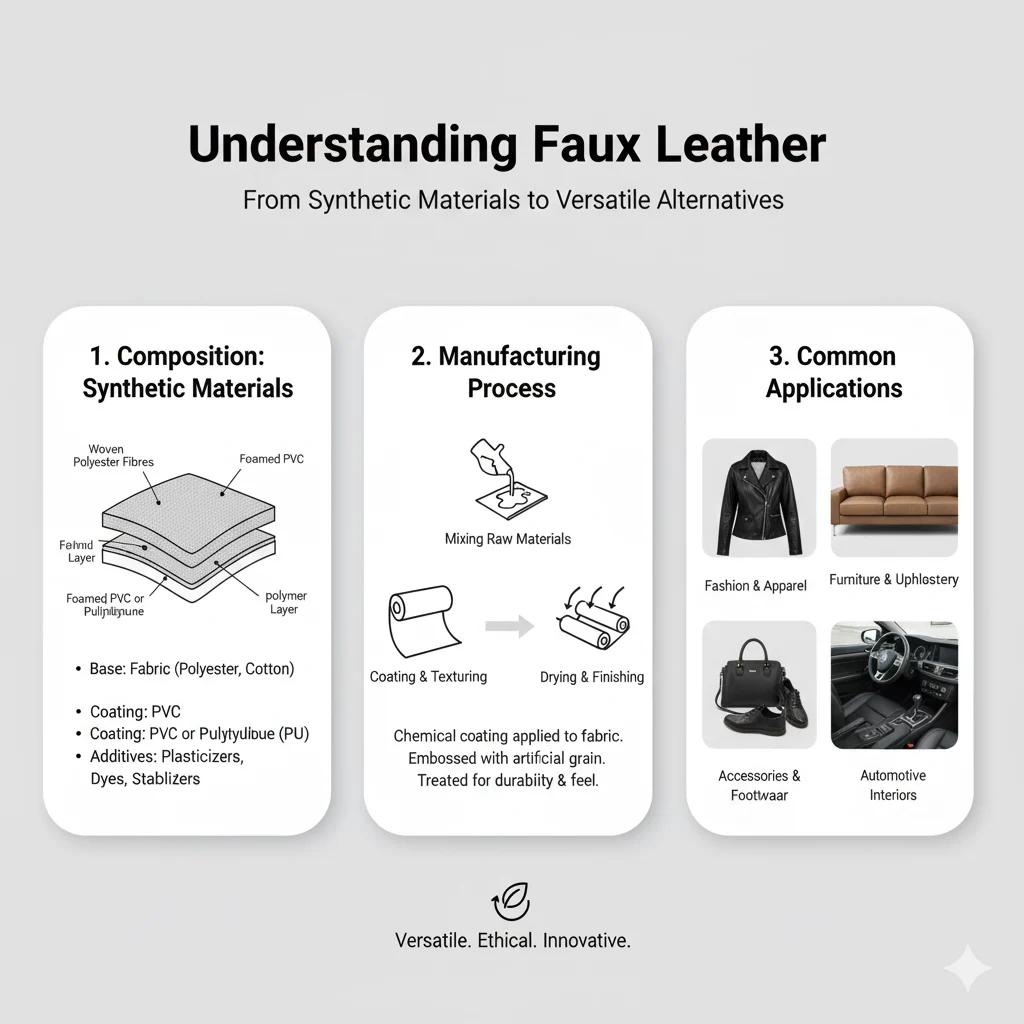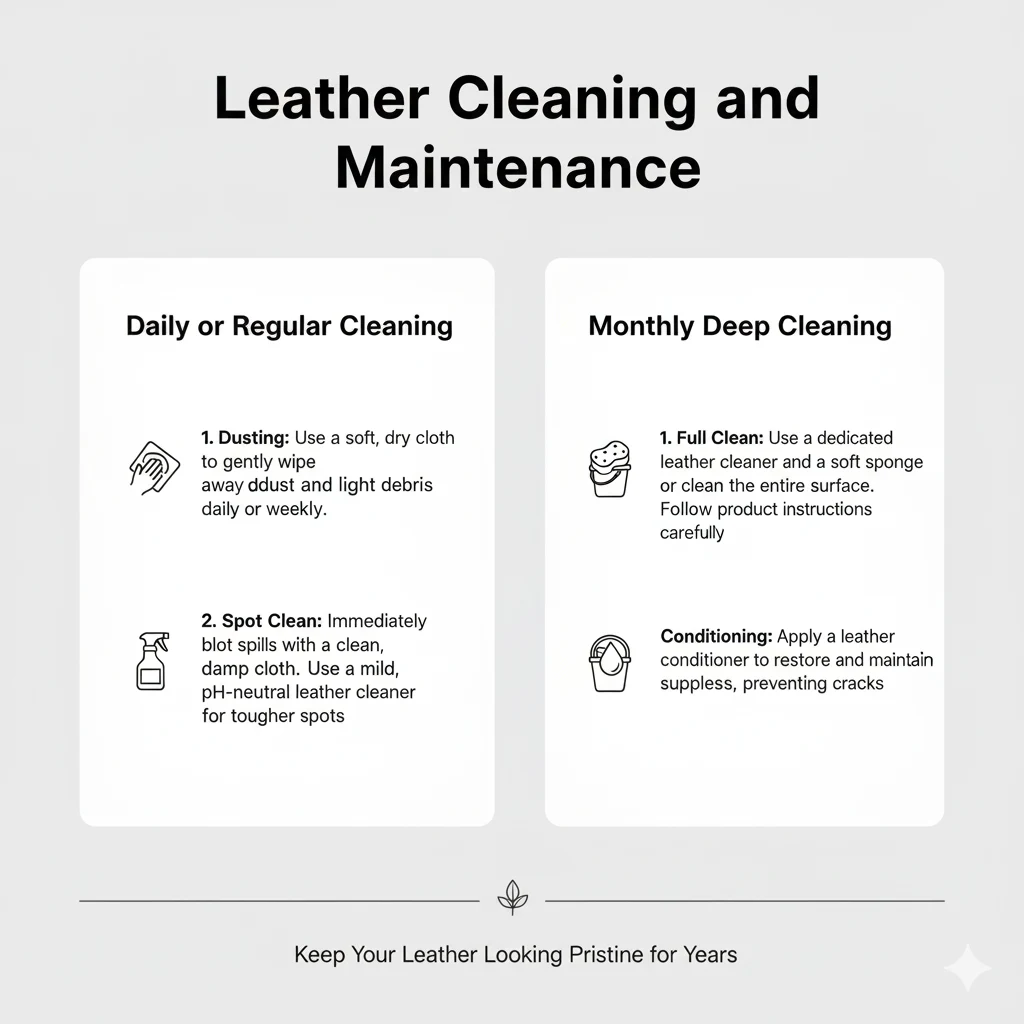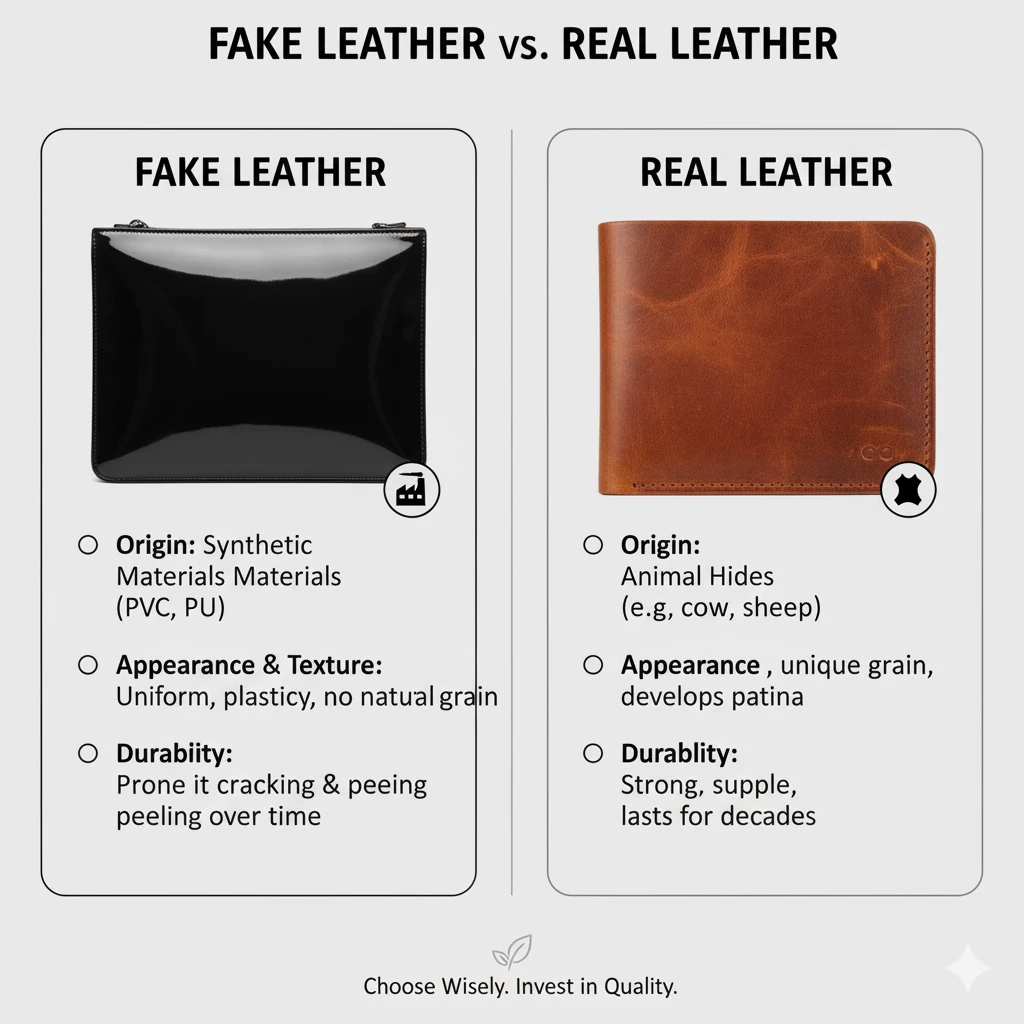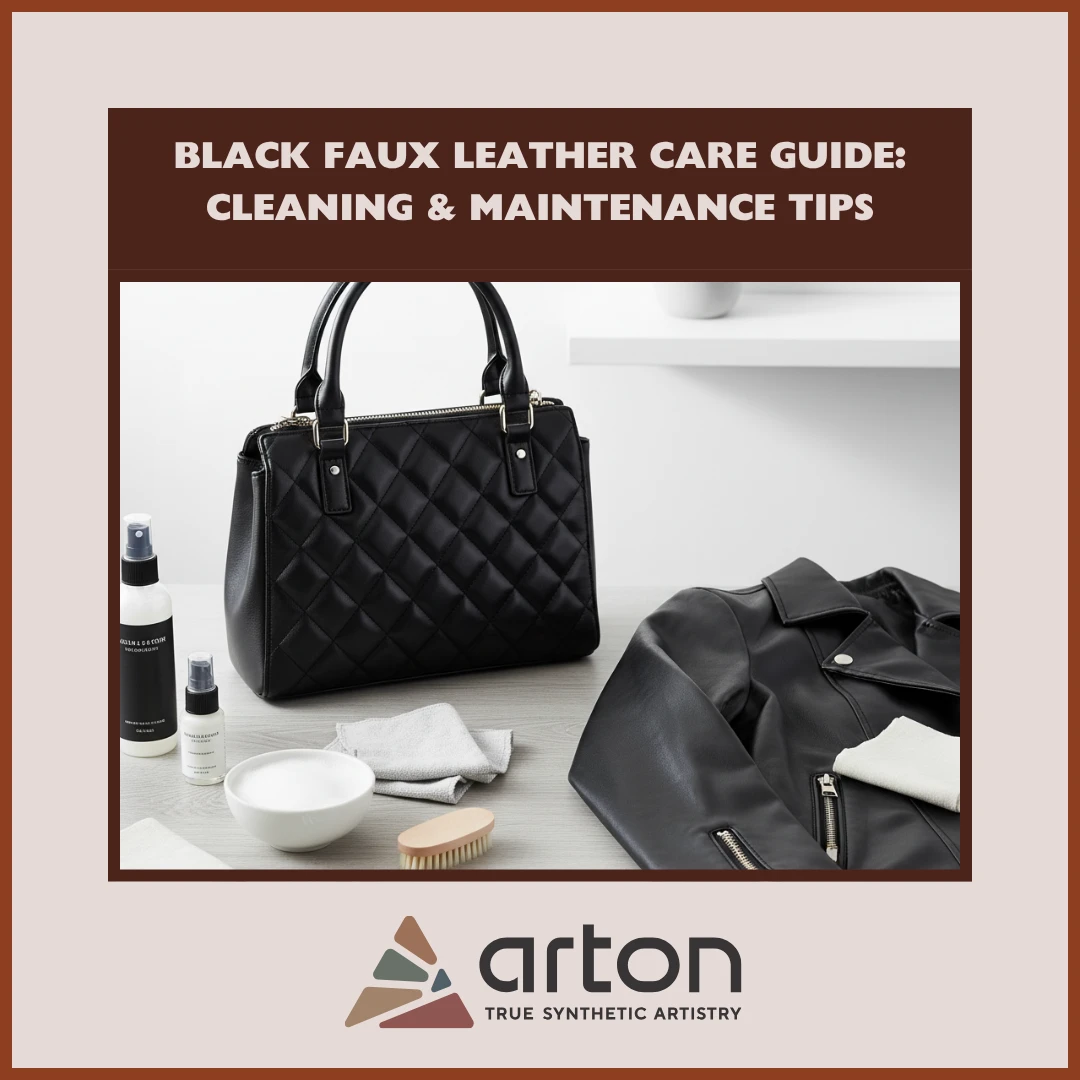03 October, 2025
Introduction to Artificial Leather
Faux leather, widely known as synthetic leather, vegan leather, or imitation leather, is not just an alternative to genuine leather; it’s a modern solution that caters to fashion-conscious, budget-friendly, and eco-aware consumers all at once. Within the broad category of leathers, which includes both genuine and synthetic types, faux leather stands out for its cruelty-free composition and distinct characteristics compared to traditional animal-derived leathers. Unlike real leather, which comes from processed animal hides, faux leather is carefully engineered to mimic the classic appearance and feel of genuine leather while remaining cruelty-free. This quality makes it a top choice in global markets, especially as more people seek sustainable and animal-friendly lifestyles.
The material itself is created using advanced polymers like polyurethane (PU) and polyvinyl chloride (PVC). These are layered over durable fabric bases, cotton, polyester, or nylon, to give the final product strength, flexibility, and resilience. Each layer is engineered to contribute specific benefits: the fabric backing provides stability, the polymer coating ensures the leather-like finish, and surface embossing delivers realistic grain patterns. In the case of PVC leather, a foam layer is often included beneath the surface, which enhances durability and weather resistance.
Thanks to these processes, faux leather products are available in an extensive variety of applications. From black faux leather jackets that add sophistication to wardrobes, to faux leather sofas that transform living spaces with elegance, to car seats and handbags that need both style and durability, the material is used in countless ways. Consumers enjoy the luxury aesthetic of leather at a fraction of the cost, while avoiding the ethical concerns of animal-derived materials.
However, faux leather also has its own limitations, which are quite different from real leather. Instead of softening and developing a natural patina, faux leather can peel, wrinkle, or crack if neglected. This makes knowledge of proper cleaning, conditioning, and storage critical not only to protect your investment but to ensure your black faux leather items look fresh and polished for many years.
Understanding Faux Leather

Faux leather is not simply “fake leather”; it’s a technologically advanced composite material designed for long-term performance. Its layered structure ensures it behaves similarly to real leather but with greater consistency in look and production.
While faux leather is easier to maintain and more resistant to stains than genuine leather, it does not develop the same patina or breathability. In contrast, full-grain leather, which is considered the highest quality leather, requires deep moisturization after cleaning to preserve its durability and appearance.
Proper cleaning faux leather is essential using gentle techniques and avoiding harsh chemicals helps maintain its appearance and durability over time.
Rock Uniquoters is a leading manufacturer and supplier of high-quality PVC synthetic leather, catering to a wide range of industries, including furniture, automotive, fashion, and interior design. Known for their durable and versatile materials, they offer various textures, colors, and finishes to meet diverse design needs. With a strong focus on quality, Rock Uniquoters ensures that every sheet of synthetic leather is long-lasting, aesthetically appealing, and easy to maintain, making them a trusted choice for businesses and designers seeking premium LPVC leather solutions.
Structure and Manufacturing
-
Fabric Backing: Usually cotton, polyester, or a blend, providing flexibility and shape retention.
-
Polymer Coating: PU or PVC forms the top layer, delivering smoothness, water resistance, and stain protection.
-
Embossing & Finishing: The surface is pressed with realistic patterns (pebbled, matte, or glossy) and sometimes dyed in a wide spectrum of colors.
This manufacturing process creates highly versatile materials. For example:
-
PU leather feels soft and supple, making it ideal for jackets, bags, and accessories.
-
PVC leather, being more rigid, works better for sofas, chairs, and commercial upholstery.
Both PU and PVC leather are widely used in furniture manufacturing due to their durability and cost-effectiveness.
Strengths vs Weaknesses
-
Advantages: Faux leather is durable, easy to clean, stain resistant, and significantly more affordable than genuine leather. Its ability to mimic different finishes makes it incredibly versatile. PU leather is especially popular for clothing items because it offers better air circulation and comfort compared to PVC leather, making it a preferred choice for wearable applications.
-
Limitations: If left exposed to sunlight, heat, or heavy wear, the coating can eventually dry out and crack. Black faux leather in particular shows wear quickly if it is not maintained regularly.
Understanding these factors helps consumers establish realistic expectations and commit to the care routines that preserve longevity and beauty.
Leather Cleaning and Maintenance

Proper cleaning is the single most important habit in extending the lifespan of faux leather. Because the material has a non-porous coating, dirt and grime often sit on the surface. Fortunately, it is easy to clean faux leather using gentle methods that help preserve its appearance and durability. If ignored, these particles can cause scratches, dullness, or eventual breakdown of the synthetic finish.
When cleaning dirt, use a soft cloth and warm water to gently wipe the surface, taking advantage of faux leather's easy maintenance and protective top coat that resists stains and dirt.
Daily or Regular Cleaning
-
Jackets and Apparel: Wipe with a soft microfiber cloth after each wear to remove body oils, sweat, or environmental dust. This prevents buildup that can weaken the coating.
-
Furniture: Vacuum seams, cushions, and corners using a brush attachment to lift debris and pet hair. Regular dusting prevents grit from scratching the smooth surface.
-
Accessories: For bags and belts, a quick wipe with a damp cloth after outings helps maintain their sleek appearance.
Monthly Deep Cleaning
-
Mix warm water with a few drops of mild, non-alkaline soap such as dishwashing liquid.
-
Dampen (not soak) a microfiber cloth, ensuring it’s safe for delicate surfaces.
-
Wipe surfaces in small circular motions, lifting stains and dirt evenly.
-
Use a second damp cloth to rinse off soap residue thoroughly.
-
Dry gently with a towel and allow the item to air dry in natural ventilation.
Avoid Common Errors: Harsh chemicals (like bleach, ammonia, or acetone) strip the coating, while abrasive sponges leave permanent scratches. Over-saturation of water can also cause bubbling, peeling, or glue separation in the layers.
By dedicating just 10–15 minutes monthly, you’ll maintain the deep black finish of faux leather and protect it from premature aging.
Leather Conditioner and Protection
While faux leather does not require conditioning to “feed” pores like real leather, it still benefits from surface protectants formulated for synthetics. These conditioners help the material remain flexible and smooth while adding a thin shield against spills and stains. For best results, after applying the conditioner, allow it to absorb for a few hours before buffing or using the item.
How to Apply Conditioner
-
Pour a small pea-sized amount of faux leather conditioner or vinyl protectant onto a soft microfiber cloth.
-
Rub it gently into the surface in circular strokes, covering seams and edges where cracking often begins.
-
Let it sit briefly, then buff with a dry cloth to enhance shine and remove any excess residue.
Why It Matters
-
Flexibility: Prevents brittleness that leads to cracks, especially in areas that bend often, such as jacket sleeves or sofa cushions.
-
Appearance: Enhances the smooth, luxurious look of black faux leather, keeping it vibrant and fresh.
-
Protection: Adds resistance against stains and everyday spills, prolonging the material’s life.
For black faux leather, conditioning every 8–12 weeks is ideal. Accessories may require less frequent treatment but still benefit from occasional conditioning to avoid dullness.
Comprehensive Guide to Leather Care
Think of faux leather care as a multi-layered approach regular cleaning, proper conditioning, and mindful usage habits all work together to maximize longevity.
Environmental Awareness
-
Sunlight: Continuous exposure causes fading, particularly on dark surfaces like black faux leather, turning them gray or patchy.
-
Heat: Proximity to heaters or car dashboards in summer leads to warping, peeling, or cracking.
-
Cold: Freezing weather stiffens the coating, making it brittle and vulnerable to stress cracks.
Practical Daily Habits
-
Rotate cushions on sofas to distribute wear evenly.
-
Always hang jackets on wide padded hangers rather than thin wire ones to preserve their shape.
-
Apply protective sprays to shoes and handbags before wearing them in rainy conditions.
When cleaning, always finish with a drying stage to avoid trapped moisture, and never store damp items. These consistent habits will drastically extend the life of your faux leather pieces.
Air Circulation and Storage
Improper storage ruins more faux leather items than daily use. Maintaining airflow is critical. Better air circulation helps prevent moisture buildup and extends the life of faux leather items.
Why Ventilation Matters
Faux leather’s non-porous surface traps moisture. Without circulation, this humidity causes mildew, sticky textures, or bubbling in the synthetic layer. Black faux leather, being dark, absorbs more heat and worsens these issues.
Best Practices for Storage
-
Do not seal items in plastic bags, which trap condensation.
-
Use breathable cotton or canvas garment bags for jackets and dust covers for accessories.
-
For furniture, position away from damp walls or poorly ventilated spaces.
Cover long-stored items with soft fabric sheets or acid-free paper to block dust while allowing airflow. This protects both the deep black color and supple texture, ensuring items remain ready to use.
Polyvinyl Chloride and Faux Leather
PVC, also known as vinyl leather, is one of the earliest forms of artificial leather, still widely used for budget-friendly furniture and commercial applications.
Benefits
-
Affordable: Its low production cost makes PVC leather a common choice in mass-market furniture.
-
Durable Surface: Resistant to spills and stains, making it practical for restaurants or offices.
-
Moisture Resistant: Ideal for outdoor furniture, boat seating, or environments where water exposure is common.
Limitations
-
Breathability: Virtually nonexistent, making it uncomfortable for prolonged wear in clothing.
-
Texture: Feels rigid compared to PU leather, with less natural softness.
-
Aging: Tends to harden and crack faster as plasticizers evaporate with use.
PVC leather remains practical for low-maintenance, high-traffic environments, but it requires extra attention if you want to extend its lifespan.
Leather Goods Care
Caring for Bags, Shoes, and Accessories
When it comes to keeping your favorite bags, shoes, and accessories in top condition, a little attention goes a long way especially with faux leather and vegan leather items. Start by gently wiping away loose dirt and dust with a microfiber cloth after each use. For faux leather goods, a quick pass with a damp cloth is usually enough to clean the surface, but always be careful to avoid excess moisture, which can weaken the material or cause the fabric backing to separate.
If you’re caring for genuine leather or top grain leather accessories, use a soft cloth and a mild soap solution to lift away grime, then follow up with a clean, dry cloth to remove any residue. Conditioning is key for real leather apply a leather conditioner every few months to keep the material soft and supple. For faux leather and vegan leather, similar care routines help maintain their appearance and flexibility, even though they don’t absorb conditioner in the same way as real leather.
For shoes, pay special attention to seams and textured areas where dirt can accumulate. Use a soft brush or cloth to gently rub away debris, and let items air dry naturally after cleaning. By following these simple steps, you’ll keep your leather goods whether made from synthetic materials or genuine leather looking polished and ready for everyday use.
Faux Leather Upholstery
Maintenance for Furniture and Car Interiors
Faux leather upholstery is a smart, cost-effective choice for both furniture and car interiors, offering impressive durability and stain resistance. To keep your faux leather upholstery looking its best, start with regular cleaning using a soft-bristled brush or a microfiber cloth to remove loose dirt and dust from the surface and seams. This simple routine helps prevent grit from scratching the polyurethane coating and keeps the material feeling soft and supple.
For more stubborn stains, mix a mild soap solution with warm water and gently apply it to the stained area using a clean cloth. Always test the solution on a hidden spot first to ensure it won’t affect the color or finish. Both PU leather and PVC leather common types of faux leather used in upholstery respond well to this method, but avoid harsh chemicals that can damage the protective layer.
After cleaning, wipe the area with a damp cloth to remove any soap residue, then dry thoroughly with a soft cloth. Regular maintenance not only preserves the appearance of your faux leather furniture and car seats but also extends their lifespan, ensuring they remain a stylish and practical part of your home or vehicle for years to come.
Leather Maintenance and Repair
Even with the best care, faux leather items can sometimes develop minor issues like scratches, cracks, or peeling especially in high-use areas. Addressing these problems early can make a big difference in maintaining the look and feel of your favorite pieces.
For small scratches or scuffs, gently rub the area with a soft cloth dampened with a mild soap solution, then dry with a clean cloth. If the damage is more significant, such as minor cracks or peeling, consider using a faux leather repair kit designed for synthetic materials. These kits often include a filler and color-matching compounds that can restore the surface’s appearance. Always clean the area thoroughly before applying any repair products, and allow ample time for the material to air dry during the process.
To prevent further damage, avoid exposing your faux leather items to harsh conditions, such as direct sunlight, excessive heat, or prolonged moisture. Regularly conditioning the surface with a product formulated for synthetic leather can help maintain flexibility and reduce the risk of future cracks. By taking these proactive steps, you’ll extend the life of your faux leather goods and keep them looking their best, whether they’re part of your wardrobe, furniture, or car interior.
Fake Leather vs Real Leather

Comparing synthetic leather to real leather reveals both trade-offs and advantages.
Real Leather
-
Made from animal hides, giving it a unique texture with natural imperfections.
-
Extremely durable and develops a patina that many consider more beautiful with age.
-
Breathable, making it comfortable in clothing and car seats.
-
Requires regular conditioning and comes at a higher price point.
Faux Leather
-
Constructed from PU or PVC polymers, ensuring consistent color and finish.
-
Affordable and widely accessible, suitable for fast fashion and home décor.
-
Easier to maintain simple soap-and-water cleaning usually suffices.
-
Shorter lifespan but continually improving with innovations in material science.
Ultimately, the choice depends on values: budget and ethics favor faux leather, while longevity and luxury favor real leather.
Additional Care Tips for Black Faux Leather
Black faux leather, while striking and elegant, also highlights imperfections more than lighter shades.
-
Wipe frequently with a damp microfiber cloth to keep the surface glossy.
-
Use special black leather restorer creams for fading areas, applying carefully and buffing for an even tone.
-
Avoid contact with sharp jewelry, belts, or pets’ claws that leave visible scratches.
-
Always test conditioners or cleaners in a hidden corner to prevent streaks or discoloration.
By following these black-specific care strategies, your items will retain their deep, rich finish and polished look for far longer.
Common Mistakes to Avoid
Most premature damage happens due to avoidable errors:
-
Using alcohol or bleach cleaners strips the surface permanently.
-
Over-wetting with water weakens adhesives and causes peeling.
-
Skipping routine cleaning allows grime to harden, dulling surfaces.
-
Improper storage in plastic bags encourages mildew and warping.
-
Neglecting conditioner causes brittleness and cracks in high-stress areas.
Avoiding these pitfalls ensures faux leather stays functional, comfortable, and stylish for years.
Conclusion
Faux leather is a smart, affordable, and ethical substitute for genuine leather, but it thrives only with proper maintenance. Black faux leather, while elegant, demands more attention since dust, scratches, and fading appear quickly.
The key lies in regular cleaning, proper conditioning, and careful storage. By wiping down surfaces weekly, conditioning every few months, and avoiding exposure to harsh environments, your faux leather items whether jackets, handbags, car seats, or sofas will stay polished and long-lasting.
Handled with care, faux leather becomes a dependable investment that combines style, practicality, and ethics. With the right habits, your favorite black faux leather items will maintain their luxurious appearance and usability for years to come.



